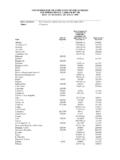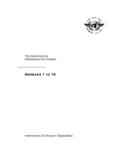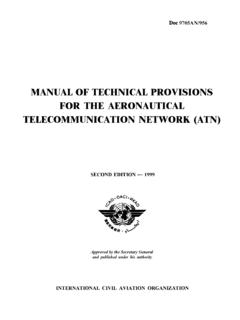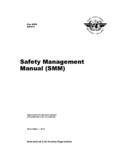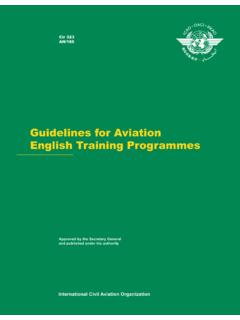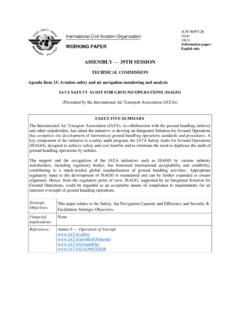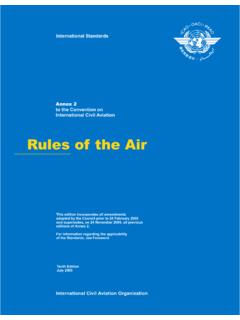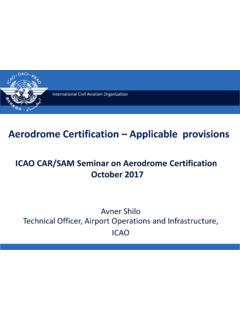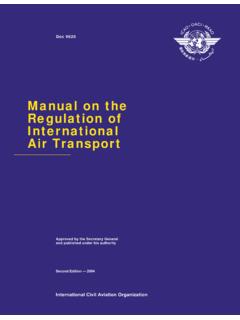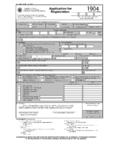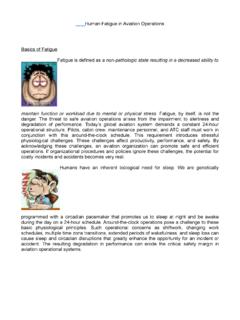Transcription of Operation of Aircraft - International Civil Aviation ...
1 Excerpts of fatigue management-related provisions from: International Standards and Recommended Practices Adopted on 25 February 2013 Applicable from 14 November 2013. International Civil Aviation Organization Operation of Aircraft _____ Annex 6 to the Convention on International Civil Aviation Part I International Commercial Air Transport Aeroplanes International STANDARDS AND RECOMMENDED PRACTICES CHAPTER 1. DEFINITIONS .. Fatigue. A physiological state of reduced mental or physical performance capability resulting from sleep loss or extended wakefulness, circadian phase, or workload (mental and/or physical activity) that can impair a crew member s alertness and ability to safely operate an Aircraft or perform safety-related duties.
2 Fatigue Risk Management System (FRMS). A data-driven means of continuously monitoring and managing fatigue-related safety risks, based upon scientific principles and knowledge as well as operational experience that aims to ensure relevant personnel are performing at adequate levels of alertness.. CHAPTER 4. FLIGHT operations .. Fatigue management The State of the Operator shall establish regulations for the purpose of managing fatigue. These regulations shall be based upon scientific principles and knowledge, with the aim of ensuring that flight and cabin crew members are performing at an adequate level of alertness.
3 Accordingly, the State of the Operator shall establish: a) regulations for flight time, flight duty period, duty period and rest period limitations; and b) where authorizing an operator to use a Fatigue Risk Management System (FRMS) to manage fatigue, FRMS regulations. Note. Guidance for the development of prescriptive regulations to manage fatigue is given in Attachment A and detailed requirements for an FRMS are in Appendix 7. The State of the Operator shall require that the operator, in compliance with and for the purposes of managing its fatigue-related safety risks, establish either: a) flight time, flight duty period, duty period and rest period limitations that are within the prescriptive fatigue management regulations established by the State of the Operator; or b) a Fatigue Risk Management System (FRMS) in compliance with for all operations .
4 Or c) an FRMS in compliance with for part of its operations and the requirements of a) for the remainder of its operations . Note. Guidance for the implementation and oversight of an FRMS is given in the Fatigue Risk Management Systems Manual for Regulators (Doc 9966). Where the operator adopts prescriptive fatigue management regulations for part or all of its operations , the State Annex 6 Operation of Aircraft Part I of the Operator may approve, in exceptional circumstances, variations to these regulations on the basis of a risk assessment provided by the operator.
5 Approved variations shall provide a level of safety equivalent to, or better than, that achieved through the prescriptive fatigue management regulations. The State of the Operator shall approve an operator s FRMS before it may take the place of any or all of the prescriptive fatigue management regulations. An approved FRMS shall provide a level of safety equivalent to, or better than, the prescriptive fatigue management regulations. States that approve an operator s FRMS shall establish a process to ensure that an FRMS provides a level of safety equivalent to, or better than, the prescriptive fatigue management regulations.
6 As part of this process, the State of the Operator shall: a) require that the operator establish maximum values for flight times and/or flight duty periods(s) and duty period(s), and minimum values for rest periods. These values shall be based upon scientific principles and knowledge, subject to safety assurance processes, and acceptable to the State of the Operator; b) mandate a decrease in maximum values and an increase in minimum values in the event that the operator s data indicates these values are too high or too low, respectively; and c) approve any increase in maximum values or decrease in minimum values only after evaluating the operator s justification for such changes, based on accumulated FRMS experience and fatigue-related data.
7 Note. Safety assurance processes are described in Appendix 7. Where an operator implements an FRMS to manage fatigue-related safety risks, the operator shall, as a minimum: a) incorporate scientific principles and knowledge within the FRMS; b) identify fatigue-related safety hazards and the resulting risks on an ongoing basis; c) ensure that remedial actions, necessary to effectively mitigate the risks associated with the hazards, are implemented promptly; d) provide for continuous monitoring and regular assessment of the mitigation of fatigue risks achieved by such actions.
8 And e) provide for continuous improvement to the overall performance of the FRMS. Note. Detailed requirements for an FRMS are in Appendix 7. Recommendation. States should require that, where an operator has an FRMS, it is integrated with the operator s SMS. Note. The integration of FRMS and SMS is described in the Fatigue Risk Management Systems Manual for Regulators (Doc 9966). An operator shall maintain records for all its flight and cabin crew members of flight time, flight duty periods, duty periods, and rest periods for a period of time specified by the State of the Operator.
9 Part I Annex 6 Operation of Aircraft APPENDIX 2. ORGANIZATION AND CONTENTS OF AN operations MANUAL (See Chapter 4, ) .. 2. Contents The operations manual referred to in and shall contain at the least the following: General Instructions outlining the responsibilities of operations personnel pertaining to the conduct of flight operations . Information and policy relating to fatigue management including: a) rules pertaining to flight time, flight duty period, duty period limitations and rest requirements for flight and cabin crew members in accordance with Chapter 4, a); and b) policy and documentation pertaining to the operator s FRMS in accordance with Appendix 7.
10 APPENDIX 7. FATIGUE RISK MANAGEMENT SYSTEM REQUIREMENTS Note. Guidance on the development, implementation, approval and monitoring of an FRMS is contained in the Fatigue Risk Management Systems Manual for Regulators (Doc 9966). A Fatigue Risk Management System (FRMS) established in accordance with Chapter 4, , shall contain, at a minimum: 1. FRMS policy and documentation FRMS policy The operator shall define its FRMS policy, with all elements of the FRMS clearly identified. The policy shall require that the scope of FRMS operations be clearly defined in the operations manual.
